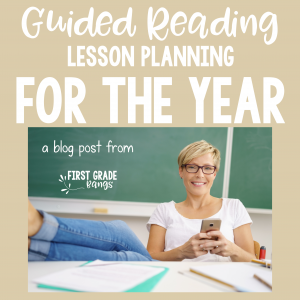
Have you ever wished you could come up with lesson plans that you could use over and over again?
Do you wish your guided reading had more PUNCH- more power to connect to those topics you are teaching in reading? Wouldn’t it be great to get your guided reading lesson planning done FOR THE YEAR?
Over the past three years, I developed a super-easy plan to do just that in my classroom.
It is SIMPLE for me and it’s ENGAGING for my students.
Our guided reading lessons are based on the topics we cover in our Reader’s Workshop mini-lesson.
That’s it.
Except for my group of super-low readers who are struggling with decoding, I put all of my efforts into teaching those Reader’s Workshop topics really well by reinforcing them in our small group reading. I have seen my students’ comprehension and application of these topics SOAR by using this 6 step method.
Wanna give it a try? Here are the 6 simple steps to doing just that:
Six Simple Steps to Guided Reading Lesson Planning FOR THE YEAR
Step 1
Choose the topics you will cover in Reading or Reader’s Workshop this year.
Create a quick spreadsheet or table- list your topics in the order you will teach in the left column, and along the top, write out the reading levels you typically cover in your grade level. Here is what my empty spreadsheet looks like for the first semester:
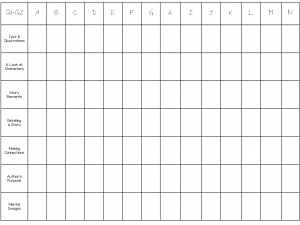
Step 2
Find books for each level that match each topic really, really well. Take your time with this step!!!! You are looking for really high-quality literature. Think in terms of a teacher AND a student. Is the book engaging? Is the topic obvious and easy to identify if you are introducing a topic for the first time?
Or if you are working with higher-level readers, will they have to really think and dig through the text to uncover it? That may be your goal, especially if the students have been introduced to the topic in years past.
Fill the titles in your spreadsheet from above. Here is what my finished first-semester spreadsheet looks like:
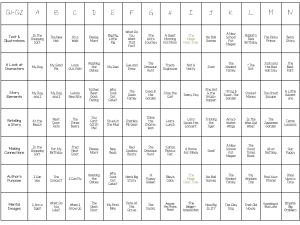
Notice the titles I highlighted in green? Those are important! Maybe you’ve found a good book, but you can’t decide if you should use it for Text & Illustrations or Author’s Purpose. DO BOTH!!! I usually find that quality literature can be used for more than one purpose. Many of my books are used up to 3 times a year. I do try to spread it out, so maybe one time I use it in September when we are covering Text & Illustrations, and then again in December for Author’s Purpose, and then again in April when we are studying Character Development.
Re-using books for multiple purposes will make your life SO MUCH EASIER!!!! You will be intimately familiar with the text, but the students will be different- remember if you are using a Level I book in September and then again in December, those will be different students! Or at least they should be! I’m sure your students won’t be stalled on a level for 3 months.
Writing out the plans will be easier, too, if you are re-using books, which brings us to….
Step 3
Come up with a good mix of discussion questions for each book.
Your questions should be a mix of lower-level and higher-level questions. I usually have some questions that are specific to the book, and then a few that really pull out the topic we are covering.
Remember how I told you re-using books would make planning easier? Just use the book-specific questions over again in your new plans. Now you only need to come up with a few topic-specific questions and you are DONE with this step!
Step 4
Decide upon some logical Word Work and Reader’s Response activities for each book. Some books just lend themselves to some great discussions on contractions, ordinal number words, compound words, etc. I like to write these down so I can remember to use them each time we read the book.
Will I also work on phonemic, phonics, and word work that my specific students need? Of course. Those I can’t add into my typed-up plans, though. Those activities will be student-specific and more spur-of-the-moment. Teachable moments, if you will. We read each book for 2-3 days, so I usually plan one word work activity and let the others come up as needed.
I keep my list of Word Work activities from the Stress-Free Guided Reading document handy, as well as a drawer full of whiteboards, magnet letters, etc. That way I can toss in those activities at the last minute.
What if you are not great at spur-of-the-moment plans or run out of time? I usually take note of what pops in my head as I am listening to the kids read and jot it down on a sticky note. At the end of the lesson, I put the sticky note on top of the books as I put them back in the group’s drawer and when I open it up the next day, BOOM- there is my note reminding me of what that group could really use a refresher in (or introduction to).
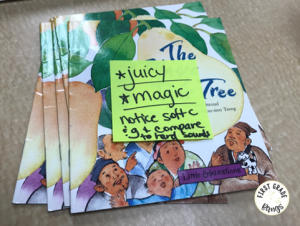
If I need more time to reflect and go over the informal running records/notes I have been taking while the student read, that’s fine, too. I use my planning time to re-read, reflect, come up with a word work plan, then jot that down on the sticky note. Either way works!
Step 5
Type up your plans, print them out, put them in plastic sleeves, and assemble them in a binder. I like to put in tabs for each topic, then place the lesson plans in leveled book order behind each tab.
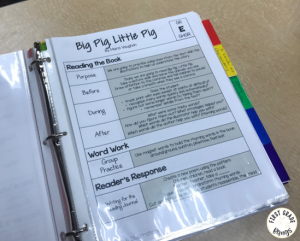
Ta-da! You are DONE with lesson planning for Guided Reading for the YEAR!
All you need to do is pull out the individual plans needed each week, throw them in the drawer or tub with the books for each group, and you are ready to go.
SIMPLE. ENGAGING.
DONE.
If this sounds good to you, click below to download the Stress-Free Guided Reading freebie and I will walk you through the details of the Stress-Free Guided Reading system.
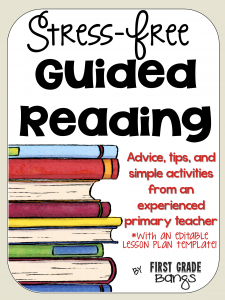
Want to read more about Stress-Free Guided Reading? Click the titles below to go straight to those blog posts and get more info.
What is Stress-Free Guided Reading?
Guided Reading- Are you planning TOO MUCH or TOO LITTLE?
Or these related posts:
16 Insanely Simple Word Work Tricks You Need To Know
Step by Step Instructions for Getting Centers Started
5 Simple Steps for Successful Literacy Centers
Have any questions? Got any great ideas you love to use with guided reading? I’m all ears! I absolutely love to connect… just comment below and share your thoughts!
Your friend in the trenches,

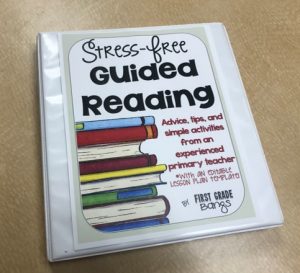
Leave a Reply